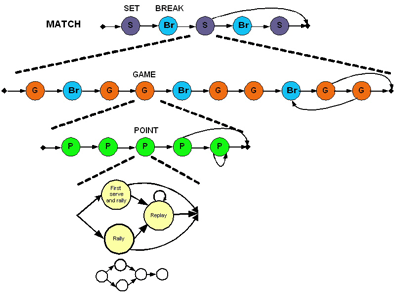
This issue in pdf Subscription Archive: Next issue: October 2005 |
|
|||||||
Multimedia Indexing: The Multimedia Challengeby Patrick Gros, Manolis Delakis and Guillaume Gravier Multimedia indexing is a very active field of research, despite most works using only a single medium. This is mainly due to the fact that while they may be correlated, media are not strongly synchronized. Segment models appear to be a good candidate to manage such a desynchronization. Multimedia indexing has become a general label to designate a large domain of activities ranging from image description to description languages, from speech recognition to ontology definition. Of course, these fields existed before the expression ‘multimedia indexing’ became popular, and most continue to have an independent existence. However, the rise of multimedia has forced people to try to mix them together in order to manage properly big collections of multimedia documents. The global goal of multimedia indexing is to describe documents automatically, especially those containing images, sounds or videos, allowing users to retrieve them from large collections, or to navigate these collections easily. Such documents, which used to be rare due to the price of acquisition devices and because of the memory required, are now flooding our digital environment thanks to the camera-phones, webcams, digital cameras, as well as to the networks that allow the data to be widely shared. The question is no longer “How can I acquire a digital image?”, but rather “How can I retrieve the image I want?” What Does Multimedia Change? If one considers a TV stream, it is apparent that images are not able to provide a lot of semantic information. The information that can be extracted from this medium includes segmentation information (shot detection, clustering of neighbouring shots), face detection and recognition capabilities, and text and logo detection. It is possible to do a lot more but only in very limited contexts, like news reports or sports broadcasts. In such contexts, syntactic cues like outdoor/indoor classifications have a pertinent semantic translation (anchor person/outdoor reports), but these tricks cannot be used in open contexts. The situation is similar in audio analysis. Cries and applause are good indications of interesting events in sport reports, but not in drama and films. On the other hand, audio can provide useful segmentation information (music or speech detection), speaker detection and recognition, key sound detection, or speech transcription capabilities. There may be several sources of interesting text, eg internal sources like closed captions, text included in the images, speech transcription or external sources such as program guides. The Big Challenge: Mixing Media Two common solutions to this problem exist in the literature. The first is to use the media in a sequential manner. One medium is used to detect some event, and another medium is then used to classify it. For example, audio can be used to find the most important events in a soccer game, while video is necessary to understand what kind of event it is. Such an approach does not require a theoretical framework, remains ad-hoc and is not so difficult to implement, and is a good starting point for many problems. The second uses Hidden Markov Models (HMMs) to describe and recognize sequences of events. Markov models are of common use in sound and image processing and are very suited to identifying sequences of events. This is thanks to the Viterbi algorithm, which is based on a dynamic programming approach and provides a global optimal solution at a reasonable cost. Segment Models: A Promising Approach We propose using an enhanced version of these models called segment models (SMs). In these models, each state can accept a variable number of observations, this number (or its distribution) being a new parameter of the state. On the one hand, such a model allows a different number of visual and audio observations for a given audio-visual event. On the other hand, it adds some complexity to learning the conditional probabilities of the observations, and to identifying the duration of each state in the data streams. Our first results show that segment models can outperform Markov models. However, the main work is now to determine how much flexibility we can gain, and what can be done that was impossible before.
We present the performance of HMMs and SMs on a test set of three tennis games. The task is to segment the complete video into predefined scenes, namely ‘first missed serve and exchange’, ‘exchange’, ‘replay’, and ‘break’. In this context, a state in SMs represents a complete scene rather than a shot, as in HMMs. Performances are measured in terms of percentage of shots assigned with the correct scene label (C), and recall (R) and precision (P) rates on scene boundaries detection. We use shot-based audio descriptors in HMMs. The video part of the observations of a scene for SMs is modelled via HMMs, operating as observation scorers. The audio part is modelled by unigram models of audio events (SM1gram) that fuse audio descriptors as in HMMs but at the scene level, or by bigram models (SM2gram) that can capture a succession of audio events inside a scene.
Please contact: |
|||||||



